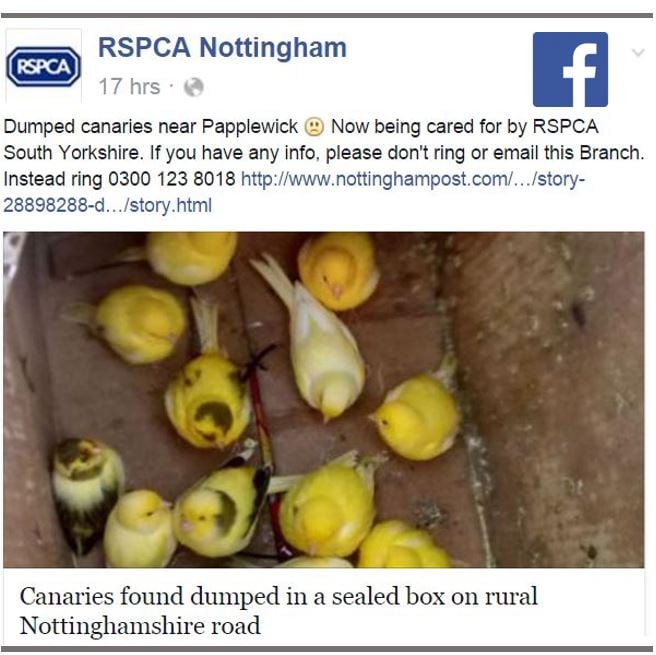Seventeen soaked canaries had been abandoned in a box with no air holes – it had been sealed shut – on one of the coldest nights this year in rural Nottinghamshire. The RSPCA, which is investigating the ‘sickening and cruel’ act, said the birds were in a bad way.
The Nottingham Post reported that a passer-by found the canaries at the side of Blidworth Waye, in the village of Papplewick on 1st March.
The canaries, which originate from the Canary Islands, Azores, Madeira and Morocco – warm regions – were wet through and freezing cold after being left out overnight in near-zero temperatures. It had rained for much of the night.
 If whoever abandoned them decided they did not want them any more, why didn’t they look for some new owners or contact the RSPCA? Leaving them to die in such a callous and cruel way is horrific. (Image: facebook.com)
If whoever abandoned them decided they did not want them any more, why didn’t they look for some new owners or contact the RSPCA? Leaving them to die in such a callous and cruel way is horrific. (Image: facebook.com)
No consideration for the birds’ welfare
According to the RSPCA, whoever dumped them clearly did not care whether the birds suffered. He or she had made no air-holes in the box, which had been sealed shut. The birds had no food or drinking water.
Karen Brannan, who works at the RSPCA as an Animal Welfare Officer, said:
“We don’t know for sure how long they were there for, but they were in a bad way as they had been left with no food, water or perch. The box had been sealed shut and there were no air-holes to give the birds oxygen.”
“They were very cold and were all huddled up together, standing in their own faeces. It was so sad to see and I am so glad that they were found when they were.”
 The canaries were found in this soggy box, which had no air-holes, food or drinking water. (Image: RSPCA)
The canaries were found in this soggy box, which had no air-holes, food or drinking water. (Image: RSPCA)
Domestic Canary
The Domestic canary (Serinus canaria forma domestica) is a domesticated form of the wild canary, a songbird of the finch family originating from the Canary Islands, Azores and Madeira (the Macaronesian Islands).
They were brought over by Spanish sailors to the European mainland, and were first bred in captivity in the seventeenth century. It soon became an expensive and fashionable bird to breed in the courts of Spanish and English monarchs.
Monks began breeding them and only sold the males – the female does not sing. This made sure demand always exceeded supply, which kept the price high. If you cannot get hold of a male and female, you cannot breed them.
Eventually Italian bird breeders managed to get hold of some females (hens) and bred the birds, thus ending the monks’ monopoly. They became extremely popular across the whole continent.
In the UK, canaries were initially only owned by the aristocracy and wealthy families. However, when local citizens began breeding them their prices fell, and they became popular across the whole socioeconomic spectrum.
Today, the domestic canary is usually kept as a cage or aviary bird. If it is well looked after, it can live from 10 to 15 years.
 Miners used to take canaries down into the mine with them. If the bird died or had signs of distress, they would get out as fast as they could, because it meant that toxic gases had leaked into the mine and their lives could be in danger. (Image: ohiocitizen.org)
Miners used to take canaries down into the mine with them. If the bird died or had signs of distress, they would get out as fast as they could, because it meant that toxic gases had leaked into the mine and their lives could be in danger. (Image: ohiocitizen.org)
Miner’s Canary
In the past, virtually every coal mine had a canary as an early warning system. Toxic gases such as methane, carbon monoxide or carbon dioxide in the mine would kill the bird before a human.
If miners saw a dead bird, or if the canary showed signs of distress, they knew that conditions were unsafe. In 1987, the use of canaries in British coal mines was phased out.
Video – Canary and human singing together
Watch this beautiful canary singing as the young lady encourages it. Remarkable!
